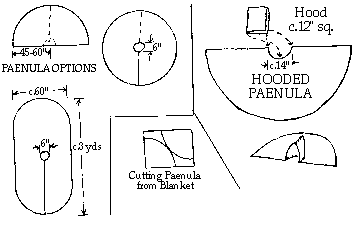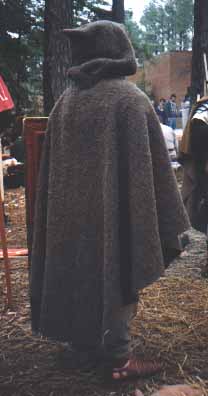
At right is Ed Safford wearing a hand-woven paenula. It is more or less semi-circular (a little longer in the back, with a rectangular hood.

CLOAK 10/15/03
There were two types of cloak in use, the sagum and the paenula. Both seem to have been some shade of brown or yellowish-brown in color; apparently a particular type of wool was preferred, its natural oils making the fabric nearly waterproof. The cloak doubles as the soldier's bedroll on campaign.
The sagum is rectangular, blanket-sized or larger. It is simply pinned with a fibula (see below) at the shoulder or throat.
The paenula may have been semi-circular, circular, or oval. A circular or semi-circular pattern should be at least 45" in radius, and can be made from 2 or more pieces sewn together with a flat overlap seam. An oval should be about 60" wide by about 3 yards long. In any case, the paenula should be knee-length or longer. A semi-circle is closed at the front either with pins, toggles, or hooks. A circle or oval has a neckhole (c. 6" diameter) and the front is slit open partway or all the way to it, with similar closures. The paenula can have a hood about 12" square sewn to the neckhole, or to a semi-circular cutout in the straight edge of the semi-circular type.
About 3 yards of 60"-wide wool is needed for a semi-circular or oval paenula, and c. 6 yards for a circular one. Allow an extra 1/3 yard for a hood, or piece it together from scraps. A semi-circular paenula can often be cut from a blanket. (The large amount of fabric needed for a fully circular paenula seems to be an argument against its use--it would be difficult to roll into a compact bundle unless the wool was quite thin.) A blanket will also make a decent sagum (remove any modern edging), or simply use 2-3 yards of wool. All cut edges may be finished with a blanket stitch or whip stitch, though some wool can be left raw-edged without fraying badly.

At right is Ed Safford wearing a hand-woven paenula. It is more or less semi-circular (a little longer in the back, with a rectangular hood. |
 |
If you cannot make your own cloak (or get one made by a fellow Roman), La Wren's Nest and Albion Armorers both make good ones.
FIBULAE
 |
Brooches or pins called fibulae
were used to pin shut tunics and cloaks, and came in a wide variety of
styles. Most were bronze, but iron, silver, and gold are known, and
decoration included enamel inlay. Some types, like the "trumpet"
brooch, could be worn in pairs connected by a chain. It is possible
that straight pins or even large thorns were used as fibulae.
At left are 3 original items, a bow brooch, a trumpet brooch (both missing their pins), and a hairpin. At right are two reproduction trumpet brooches, shown from the bottom and from the side, and a simple penannular brooch. Penannulars are very popular among reenactors because they are very easy to make (two pieces of bent brass rod), but the more complex styles of fibulae were far more common in ancient times. |
----------
*Home*Handbook Intro*Tunic*Caligae*Cloak*Belt*Helmets*Segmentata*Hamata*Squamata*Subarmalis*Scutum*Gladius*
*Pilum*Pugio*Packs*Mess
Gear*Tools*Crests*Drill*Leatherworking*Armoring*
----------
*Schedule*Handbook
*Auxiliaries *Civilian
Clothing *Cold-Weather Clothing *Signum*LINKS*SUPPLIERS*Bibliography
*
*ADLOCVTIO*Tent
and Camp *Roman Days*History*Names
*Advice
on Starting a Group *PHOTOGRAPHS*Bylaws
*Membership*